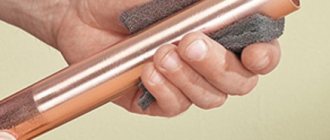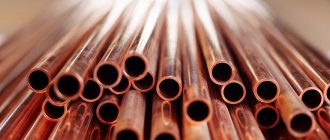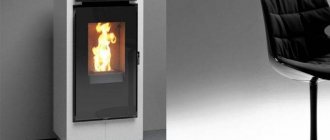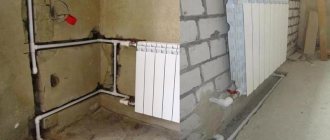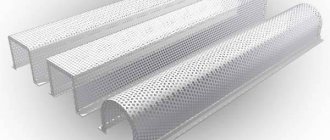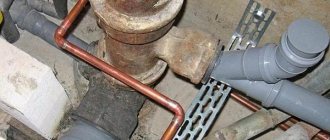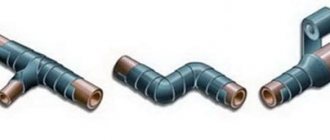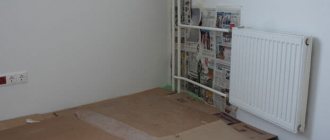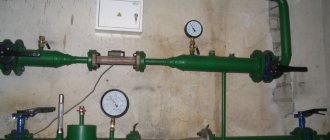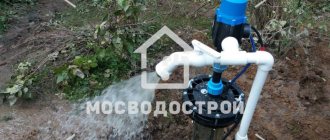Scope of application of copper pipelines
The scope of use of copper pipe products is extensive, but most often it is used for laying:
- heating systems;
- pipelines for water supply;
- highways along which compressed air or gas is transported;
- fuel pipelines;
- condensate drainage systems;
- structures for connecting technological equipment;
- pipelines supplying freon to refrigeration units;
- air conditioning systems, etc.
When is it appropriate to use copper pipes?
Copper pipes provide high resistance to temperatures exceeding 100˚C, which exist in central heating systems that operate on solid fuel boilers.
You can lay pipes on the wall without losing the aesthetic appearance.
If the heating and water supply system has many branches and involves installing a large number of fittings, then this reduces the cost of installation despite all the advantages of copper pipes and makes their use more expedient compared to other materials.
The durability of copper pipes is comparable to the life of a house, so if there are no financial restrictions, the installation of such pipes will be justified.
Characteristics of copper pipes
Naturally, the main material used to make copper pipes is copper, and of high quality. Sometimes alloys of copper and zinc are used (no more than 5%). Often, copper surfaces are coated with a polyvinyl chloride or polyethylene layer, which improves their appearance and also reduces heat loss.
For heating systems, the most suitable copper pipes are marked EN 1057, which indicates that these pipes are treated with phosphorus , which significantly increases their resistance to water.
The main advantages of copper pipes:
- Copper pipes do not corrode and are highly durable , so their service life can last up to 100 years.
- The thermal conductivity of copper is 389.6 W/mK , which is much higher than the thermal conductivity of steel, cast iron and plastic.
- Copper pipes have a wide operating temperature range. They are able to withstand both fairly high (+250 C°) and low (-100 C°) temperatures. At these temperatures, pipes do not undergo deformation , crack or melt.
- The ability of pipes and their soldered joints to withstand high (200–400 atm.) pressure is tens of times higher than that of plastic.
- Slight thermal expansion. With prolonged exposure to temperatures above 90 C°, each meter of pipe lengthens by no more than 0.1%.
- Beautiful aesthetic appearance of this material.
- Absolutely harmless to human health, since copper is an environmentally friendly, natural material.
Disadvantages of copper pipes:
- It is highly undesirable to use copper pipes in combination with other metals , as this can cause a chemical reaction, and ultimately, corrosion of the heating system. This will lead to a significant reduction in the service life of the pipes.
- The presence of “stray currents” in the heating system in certain cases can negatively affect the durability of the pipes.
The softness and elasticity of this metal in some cases can be considered a “plus” of copper pipes, and in others vice versa.
Features of heating from copper pipes
To create heating systems, copper pipes of exclusively round cross-section are used. Although manufacturers still produce rolled products with rectangular and square profiles. Products are also available in thick-walled and thin-walled versions.
The first version of pipe products is produced with a wall thickness from 0.8 mm to 10 mm using welding and a seamless method. For the second, this parameter is 0.15-0.7 mm. When installing heating with copper pipes, rolled steel is mainly used, the diameter of which is at least 3/8 inch. Regardless of the size of the product, copper heating systems have pros and cons.
Advantages and disadvantages of copper pipes in heating systems
Pipelines made of this metal have a long history: they are already more than 5 thousand years old. years. Technologies have changed, but their positive qualities remain the same:
Copper pipes can be used for a long time under certain conditions
- Long service life: with a properly designed and assembled heating system, pipes can last for decades.
- Light weight. Copper is ductile and durable, which allows you to make pipes with a small wall thickness. As a result, it turns out that it weighs a little.
- Withstands both high and low temperatures (operating temperature range from +115°C to -40°C).
- Copper of a certain grade tolerates the aquatic environment well, but for this purpose a small part of phosphorus is introduced into its composition. Such products are marked EN 1057 - in accordance with the DIN standard. Such pipes do not react with water and are used for both plumbing and heating.
- Does not require external finishing. The copper pipes themselves look attractive and do not deteriorate over time. If there is a need to paint, it is most likely due to inconsistency with the new design of the room.
Copper pipes have a fairly attractive appearance
- Not afraid of freezing: after thawing it continues to function. This is a very important quality for regions with harsh winters.
- Does not allow any gases to pass through, including oxygen, which is an active oxidizing agent.
- High resistance to oxidation.
- Smooth internal surface, which reduces the likelihood of deposits forming, unlike steel pipes (PPR and MP pipes do not have deposits).
- Low coefficient of thermal expansion.
- Like any substance, copper enters the medium it transports (with the exception of glass and ceramics). In small dosages it is useful - it has disinfectant properties. Previously, there were reports of the negative effects of large amounts of copper on health, but to date no evidence has been found and copper is not considered harmful even in large doses.
Quite a decent list of advantages. But there are also disadvantages and quite serious ones:
- Incompatibility with other materials. If there are aluminum elements in the system, active electrochemical reactions begin. When directly connected to products made from other metals, destruction occurs quickly. To improve the situation, you can use brass adapters and fittings. But it is better not to combine aluminum and copper in one system: they react, which releases a large amount of gases, so that in the absence of gas release valves the system can rupture.
In direct contact with other materials, active destruction occurs
- High price. This applies to both pipes and fittings. You also need solder, which costs a lot, and if not purchasing, then renting special equipment. The system as a whole is expensive. Especially if you consider that aluminum radiators cannot be installed, cast iron ones are a little better, but still bad, so it is advisable to install copper radiators, or bimetal with copper.
Copper pipe fittings
- If there are solid particles in the coolant, abrasion occurs quickly, since it is a soft and plastic material. Therefore, a mechanical filter is needed to remove abrasive particles from the environment.
- Insulation from stray currents is required: copper is a very good conductor of electricity. Therefore, a well-made grounding loop and the presence of dielectric spacers in the system are required.
- Difficulty of installation work: special equipment is required. But you can use bronze compression fittings, which require only wrenches (adjustable or open-end wrenches) for installation.
Crimping fittings for copper pipes can be installed by hand, but they cannot be cast into walls.
- Protection from mechanical influences or careful handling is necessary, otherwise in a few years there will be no pipes, but a shapeless pile of metal.
We recommend: Izospan A: technical characteristics of wind protection and instructions for use, which side to lay the insulation
There are several other properties that, depending on the point of view or operating conditions, can be classified as both pros and cons:
- The first is high thermal conductivity. If copper heating pipes are laid openly, they emit a fairly large amount of heat. Therefore, fewer radiators may be required. That's a plus. When laying in a closed wall or floor, careful thermal insulation is required so that the coolant through the pipe does not transfer all the heat to the wall (this is especially possible when laying in walls facing the street). This is a minus.
- Softness and plasticity. On the one hand, this is good - using a special device, pipes can be bent within fairly large limits, which leads to fewer connections and fittings. This is good. But the softness of the material means that they need to be fixed after a short interval, and in some cases special boxes must be made: at a high temperature of the coolant, copper can soften and lose its shape. This is bad. The not most pleasant moment is that upon impact, copper pipes are deformed, therefore the coolant circulation deteriorates. As a result, with careless attitude and multiple distortions, the efficiency of the system can be greatly reduced. Not good either.
Most of the problems that may arise during the operation of water pipes are associated with low quality products. And these are not advertising gimmicks, but the results of operation: a properly designed system, consisting of proven elements, works perfectly. If there is even a small fragment of “left” material, problems begin. Example: a cold water and hot water supply system is assembled from copper, all materials are of high quality, branded, with the exception of one piece of pipe (not enough) in the hot water supply, purchased from the first tray on the market. The result is that after a year and a half of operation, a blue film appeared on the plumbing fixtures to which hot water was supplied (where there was only cold water, there were no changes). The owners had to change the entire DHW comb due to the presence of an active corrosion process in the “left” section of the pipe.
Most problems with copper piping are due to poor quality materials.
To navigate brands and buy copper pipes that are suitable for heating, you need to know the types of components produced, their types, area of operation and markings.
Methods for connecting copper pipes
Welding
It is quite rare. A welding torch is used to connect copper heating pipes of large diameter (starting from a diameter of 108 mm);
Connecting copper pipes using exhaust fittings.
A hole is made inside the pipe, cams are inserted and the bell is pulled out using a special tool. A rather labor-intensive and expensive method of connecting pipes, a special machine is needed and installers do not respect this fastening option.
Rolling
The method of connecting copper pipes is good, but it is not used in heating systems. It is very rare to find a flared part, and even then a factory-made one.
Compression fitting
Happens quite often. It consists of three parts: a nut, an O-ring and the fitting itself in the form of an angle. Connection principle: a nut, an O-ring and the fitting itself are put on a copper pipe. The nut is then tightened and presses the pipe against the fitting. The same thing is done on the other side.
The disadvantage of this method of connecting a copper pipe is that there is no recommendation with what force to tighten the nut on the fitting. Everyone does this as best they can and eventually water leaks may occur.
Another disadvantage is the conditional non-disassembly of the fitting, because The sealing ring, when put on the pipe, cuts into it and remains forever. Therefore, in order to repair a section of pipe (remove a fitting), you have to cut off this section of pipe and insert a new one.
If you are offered a compression fitting, it is better to refuse and ask for something else.
Press fitting
Rarely occurs, because To install it, the master needs a set of special pliers (about twelve) and an expensive press. Connection principle: the fitting is placed on the pipe and clamped with the required type of pliers. The result is a perfectly strong, permanent connection.
The difference between the treatment of soft and hard pipes with these fittings.
A support sleeve must be inserted inside the soft copper pipe when installing a compression fitting. The bushing allows you to maintain the geometry of the pipe when compressing the support ring.
Soldering copper pipes
The method allows you to obtain a high-quality connection of a copper pipe using inexpensive equipment. This is usually a propane torch for small pipe diameters. For pipes with a diameter of more than 54 mm, an acetylene-air torch is suitable.
There are two types of soldering - hard and soft (high and low temperature). Hard soldering is performed at a higher temperature than soft soldering. There is an opinion that hard soldering is stronger than soft soldering. This is not true.
Hard soldering is less technologically advanced than soft soldering. In order to hard solder, you simply need to place the fitting on the pipe, heat the joint to a dark crimson color, and then apply solder.
Soft soldering includes:
- Cleaning the joint to a metallic shine,
- Cleaning the inner surface of the fitting,
- Flux application,
- Connecting parts
- Removing excess flux
- Actually soldering.
The main difference between soft and hard soldering is that after soft soldering the copper pipe has a neater appearance than after hard soldering. When hard soldering, the pipe becomes very hot, turns black in thickness, and becomes covered with flakes - it is impossible to clean it, it will not look like a shiny copper pipe, it will be black. After hard soldering, the boiler room looks ugly, so if they offer hard soldering, it’s better to refuse. Only soft soldering should be used.
Hard soldering of a copper pipe is suitable for cases where gas, rather than liquid, will be transported through the pipeline. For example, for air conditioning systems and systems for transporting any gases, only hard soldering is allowed, because flux residues applied to the pipe and the inner surface of the fitting end up inside the pipeline and must be washed out.
Soft soldering is suitable for hydraulic systems because... it looks more aesthetically pleasing.
Types of copper pipes
Copper pipes can be classified according to several criteria:
- According to the manufacturing method, they are divided into the following types:
Annealed pipes are produced by heat treatment. They are characterized by increased elasticity, which determines the scope of their application. In most cases, temperature-treated pipes are installed in air conditioning systems, heated floors, and refrigeration units. The main disadvantage of annealed pipes is the reduction in the strength of the material as a result of processing. Annealed pipes are produced in different diameters and are mainly sold in coils up to 50 m long;
Heat-treated copper pipes
To increase the strength index, annealed pipes can be manufactured with a protective shell.
non-annealed pipes are highly durable, but less elastic. They are mainly used when installing heating, water supply, gas supply or sewerage systems. Unannealed pipes are also manufactured in different diameters and, as a rule, are supplied in lengths of up to 5 m;
Copper pipes of various diameters
- section type. Copper pipes can be produced in round or rectangular shapes. The latter are widely used for drainage systems;
Rectangular copper pipes
- sizes. For various pipelines, it is necessary to correctly select not only the outer and inner diameters, but also the thickness of the pipe wall.
Pipe parameters that need to be taken into account when selecting
Popular copper pipe manufacturers
The most common types of copper pipes for heating:
- Sanso KME copper pipes;
- Wieland copper pipes;
- Feinrohren copper pipes;
- MKM copper pipes;
- copper pipes KME Cuprothem.
Copper pipes Sanso KME, Wieland, Feinrohren, MKM are sales leaders. The performance characteristics and quality of these pipes are quite high. Their use in heating systems can significantly reduce the cost of their installation. According to the manufacturing method, these pipes are divided into annealed and non-annealed. Annealed pipes are soft and elastic, unannealed pipes are hard, they are most used in heating systems. Mounted by hard soldering.
KME Cuprothem copper pipes are used in floor heating systems. These pipes are made in a special plastic shell. Mounted by soldering or compression fittings .
Rules for selecting pipes for various systems
Each pipeline has special characteristics, so when choosing pipes, all parameters should be taken into account.
Selection of pipes for water supply and wastewater systems
For the water supply system, round pipes with a diameter of 8 mm - 22 mm are mainly used. The wall thickness of such pipes does not exceed 1 mm.
To determine the optimal outer diameter of copper pipes for an indoor water supply system, experts use a complex mathematical formula. A simpler way to determine the diameter is as follows:
- if the pressure in the water supply system exceeds 3 atmospheres, then the minimum diameter is 8 mm;
- if more than one water tap is connected to the collector, then the minimum pipe diameter is 15 mm;
- if the water supply system is connected from a central collector, then the first connecting copper pipe with a diameter of 20 mm is installed;
- if water is supplied to the system under a pressure of less than 2 atmospheres, then the diameter of the installed pipes increases accordingly by one standard size, that is, instead of 8 mm, 10 mm should be used and so on (table of standard sizes below);
- if the length of a private water supply from the point of entry to the points of consumption is more than 20 m, then in order to obtain normal water pressure in all devices it is necessary to increase the nominal sizes of the pipes by one standard size.
Standard Typical Parameters of Copper Pipe
For drainage systems, pipes with a diameter of 32 mm to 42 mm are used.
Selection of pipes for the heating system
To calculate the diameter of the pipe in heating systems, the following parameters are used:
- pipeline layout;
- pipe resistance coefficient;
- speed of coolant movement in the system;
- diameters of inlet and outlet holes.
It is almost impossible to determine the diameter of the pipes on your own due to the complexity of the calculations, so to determine the parameter you can use the table below or the calculation method.
Calculation of the optimal pipe diameter for the heating system
The diameter of the pipe in the heating system cannot be greater than the outlet diameter of the heating equipment.
Copper pipes in the heating system are described in detail in the video.
Selection of pipes for gas supply
Depending on the pressure in the system, gas pipelines are divided into the following types:
- with low pressure (less than 0.005 MPa);
- with average pressure (0.005 MPa - 0.3 MPa);
- with high pressure (more than 0.3 MPa).
Copper pipes are allowed to be used exclusively for the installation of gas pipelines with low and medium pressure, that is, for domestic gas pipelines.
We recommend: The best stoves of 2021 for a Russian wood-fired sauna
According to regulatory documents, copper pipes are used for pipeline laying:
- with a diameter of no more than 15.9 cm;
- wall thickness up to 5 mm.
A more accurate calculation of the diameter is made exclusively by specialists.
Features of copper pipes
Important advantages of communication networks made of copper are high strength, corrosion resistance, flexibility and ductility, and durability. An important feature of copper is its ability to eliminate some bacteria, which prevents them from multiplying and settling on the inner surface of the pipe.
When installing a pipeline with your own hands, it is necessary to take into account the following factors for choosing copper pipes:
- purpose of the pipeline;
- temperature of the substances that will be transported;
- pressure in the water supply or heating system;
- pipe size;
- the presence of an insulating layer.
The disadvantage of copper pipes is their low compatibility with products made from other materials.
Copper pipes are the best option for plumbing
The most important characteristic that determines the technical parameters of the pipeline and the selection of the necessary fittings is the diameter of the copper pipe. In the construction of household systems, the most common sizes are:
| Pipe diameter, mm | Wall thickness, mm |
| 10-28 | 1 |
| 35-54 | 1,5 |
Important! With a smaller thickness, copper products have a much higher operating pressure than their steel counterparts.
More bulky systems require the installation of large copper pipes.
Installation
Before installing heating pipes, it is necessary to calculate their diameter and quantity.
Connecting copper pipes can be done in several ways:
- High temperature soldering;
- Low temperature soldering;
- Connection using fittings.
High temperature (“hard”) soldering. Such soldering is carried out at temperatures above 450°C. The parts should be cleaned with an abrasive sponge and flux (paste) should be applied to the pipe, and then the two parts should be connected. Then remove excess flux with a napkin or rag.
Important! It is prohibited to apply flux to the inner surface!
Heating system made of copper pipes.
Next, a gas burner and silver or copper based solder come into play. Using a gas torch or electric heater, the elements to be welded are heated. You should hold the fire until the solder begins to melt and fill the joints between the parts being connected, and the flux changes color.
Advice! The amount of solder must correspond to the diameter of the pipe. Experts recommend cutting the rod to the required length before starting soldering.
After soldering is completed, it is necessary to allow the connected parts to cool (at this time the parts should be motionless), then remove the remaining solder and flux, because Because of them, corrosion may form in the future. This can also be done using a dampened rag.
Important! To avoid loss of copper strength, any forced cooling is prohibited. Cooling should be natural.
90° bend. Those. floor of a high-rise building.
In addition, after completing the installation of the entire system, it is necessary to remove solder and flux from the inner walls of the pipes, because their presence also contributes to the occurrence of corrosion on the internal walls. To do this, it is necessary to circulate hot water throughout the system.
Important! High temperatures affect the hardness of copper, so when carrying out high-temperature soldering, you should not overheat the pipes so as not to damage them.
Soft solder Felder No. 3, 2 mm, 100 g.
Low temperature (“soft”) soldering. This is a less reliable connection method compared to the high-temperature method, but this is compensated by the size of the seam, the width of which can be 7-50 mm (depending on the size of the parts being connected). As a rule, it is used for soldering (at temperatures below 450°C) copper pipes for heating with a diameter of 6-108 mm. Low-melting materials such as tin or lead are used as solder. The coolant temperature in the heating system should not exceed 130°C.
Sparta - Sn60Pb40 solder. Diameter 1 mm, 50 g.
Connection using fittings. This installation method is less reliable, because such connections can withstand low pressure (up to 10 atmospheres). The connection to the pipes occurs using special press pliers that compress the fitting.
Fittings can vary in diameter: from 8 mm to 100 mm. They can be divided into 2 groups:
- straight lines connecting pipes of the same diameter;
- reduction, with the help of which copper products of different diameters are connected.
Detachable connections
Dismountable joints between segments of a copper piping system are created using compression fittings. Such connections must be periodically tightened during network operation. Therefore, they cannot be created in building structures.
Each connection is installed by sliding nuts and ferrules onto the pipes. Then tightening is done. This is done by tightening the nuts. As this operation progresses, the rings are pressed against the pipes.
Pulling the connection
Tightening must be carried out without unnecessary force, since the shape of the ends of the pipe segments should not change. Otherwise, it will not be possible to create a sealed joint.
If it is necessary to connect a copper element of the system with devices made of another metal, a transition fitting and fum tape are used. In this case, the movement of the coolant in the network must be in the direction of copper.
Solder connections
This type of joint is created when using fittings whose cross-sectional size is approximately 0.1 mm larger than the diameter of the pipes used. Soldering of copper parts is based on the capillary effect. This means that heated solder easily penetrates the gap between the elements.
When joining thick-walled products, exclusively high-temperature soldering is used. In this case, hard solders are used. Soldering can also be done at lower temperatures. This process is carried out as follows:
- the joints on the pipe element and fitting are protected with fine sandpaper;
- the areas to be joined are treated with flux;
- elements are inserted into each other;
- the joint is heated with a torch and solder is applied.
Soldering the pipeline
Actions allow you to obtain a strong connection. It must cool naturally. Until this happens, the joint should not be exposed to any influence.
If there is no torch and the required solder, then you can use a press tool and special fittings. One such device is pliers. With their help, sealed joints are created without heating the parts.
Pros and cons of copper heating pipes
The list of advantages of copper pipe products is quite long:
- Copper pipes have the longest service life among other materials used for the installation of heating systems. Modern seamless pipes can operate trouble-free for more than half a century.
- The high strength and toughness of copper makes it possible to produce pipes with thinner walls without compromising performance characteristics, while their weight compared to products made of steel or cast iron will be significantly less.
- Copper has a wide range of operating temperatures (from +600 to -110°C). At the same time, the recommended range is from +120 to -40°C, which is much higher than that of analogues made from other materials.
- Practical immunity to corrosion allows you to avoid such troubles as the formation of fistulas and breaks in the heating pipeline, as well as rust deposits on the internal surfaces of pipes.
- The aesthetic appearance of copper makes it possible to install heating systems without masking them with decorative boxes.
- The high plasticity of the material allows you to bend copper pipes without fear of damaging their structure, so you can do without the use of additional fittings and additional elements when installing a heating system.
- The increased thermal conductivity of the material increases the heating time of the room and increases the percentage of thermal energy transferred from the internal coolant to the surrounding air.
- Copper can withstand multiple freeze-thaw cycles without harm. Even if the water in the plumbing system is frozen, due to the plasticity of the material, the likelihood of a pipe rupture is extremely low.
- Unlike plastic pipes, copper products are not exposed to direct sunlight and are not destroyed by ultraviolet radiation.
We recommend that you familiarize yourself with: Types of pipes for a heating system in the floor under a screed and recommendations for selection
This is interesting! Despite the fact that manufacturers indicate the average service life of copper water pipes is about 50 years, in reality it can be much longer. In some cities in Western Europe, copper water supply systems that were installed more than a century and a half ago are still in operation.
Among the most serious disadvantages of this material, the following are worth mentioning:
- The high cost of copper products, especially in comparison with modern plastic pipes. However, with the introduction of the latest technologies and modern equipment into production, the cost of copper pipes has decreased significantly, increasing their market competitiveness.
- The installation of a copper pipeline is quite complex. For high-quality assembly, you need to have extensive experience working with this material.
- You cannot combine copper with pipes made of other metals - steel, galvanized, aluminum alloys - in the water supply network. At the place of their joints, the oxidation process sharply increases, and corrosion damage is formed.
- When installing a pipe closed into a wall, it is required to place it in a protective plastic shell. Such protection is necessary because additives contained in plaster mixtures can react with metal, causing corrosion.
How to solder copper pipes
To solder using the most popular method - using soft solder - you will need a gas torch or soldering iron, as well as a brush and flux. A layer of flux is applied to the cleaned joint from the outside with a brush, and the length of the section should correspond to the depth of immersion of the pipe into the fitting. It is recommended to measure it in advance and mark it with a marker. Like copper pipes for a heating system, the inner surface of the fitting is coated with flux, after which the parts are joined manually.
The next step is to warm up the interface with a gas torch or electric soldering iron. Here it is important to get to the point so that there is no overheating or underheating; an inexperienced installer will need preliminary training. Knowing when sufficient temperature has been reached is quite simple.
While working, you need to apply a solder wire to the surface of the pipe and at the moment when it starts to melt, start applying solder to the joint, moving the burner a little further. How to properly solder a heating system with copper pipes is shown in the video:
Installation of copper pipes
To connect copper pipes using capillary fittings, special welding is used - high-temperature soldering and silver-bronze solder. Before soldering, flux is applied to the joints of pipes and fittings. The pipe and fitting are first heated at the soldering site, and then soldered with a solder torch. For heating, an Oxygen-Propane gas station is used. Solder flows into the joints and fills the entire capillary space of the joint.
In cases where this will not affect the aesthetic appearance of the heating system, the pipes are bent at different angles. This allows you to save the number of fittings , reduce the number of connections and right angles, which will ultimately reduce the resistance to the flow of hot water. The pipes are bent using a special tool - a pipe bender. Soft pipes bend easily. Hard ones - they are preheated, then bent, after which they are allowed to cool naturally (without the use of coolants).
Aluminum radiators cannot be used in combination with copper pipes, as this will soon lead to a corrosion process. If there is a need to use aluminum radiators, then they must be connected to copper pipes through a steel pipe. This restriction does not apply to other types of radiators (steel, cast iron, etc.).
When using copper pipes in a monolith (floor and walls), it is advisable to wrap them in a protective sheath. Corrugation is quite suitable for this. Such insulation will protect the pipe from mechanical damage that can be caused by fluctuations in coolant temperature.
At first glance, the use of copper pipes for heating has become popular only in recent years. However, we should not forget that copper has been used in heating systems of domestic cars for quite some time. Copper stoves, radiators and tubes connecting them served their cars for half a century under different climatic influences, in conditions constant vibrations. Considering this fact, we can confidently assume that copper pipes will soon take a leading position in the heating systems of residential premises and other buildings.
Methods for welding copper pipes
The necessary equipment and electrodes are selected depending on the required tightness of the seams, purpose and technical characteristics. Copper pipes can be welded using electric and gas welding. Electrodes that are melting and non-melting are used.
We recommend: Pellet stove: automatic pellet stove, pellet boiler with water circuit, long-burning heating stove
Fusible electrodes
When connecting manually, coated electrodes are used, which melt. The result is a joint without defects, but the place where the copper pipe is welded will differ from the base material. This phenomenon occurs due to the presence of additional substances, alloying metals.
Additives are contained in fusible electrodes; for this purpose, silicon, manganese, phosphorus, tin and zinc additives are used. Spars, silicon copper, material based on iron and manganese, as well as ferrosilicon are introduced into the coating. Liquid glass is used for the base of the covering layer.
The disadvantages of the method include:
- decreased thermal and electrical conductivity;
- formation of a large amount of splashes;
- the appearance of pores at the junction;
- difference in the composition of the seam from copper.
To reduce defects, flux additives are used, as well as rods consisting of bronze.
Non-fusible electrodes
The pipes are connected in a protected environment, where electrodes are used that are not subject to melting during the cooking process, consisting of metal tungsten up to 10 mm in thickness. To provide a protective cloud, argon, helium or nitrogen is supplied to the weld.
The technological process takes place at a direct current with straight polarity. The electrode is a tungsten rod with the addition of lanthanum and yttrium. The movement occurs at a certain angle, and additional heating of the welding site is used.
Electrodes made of carbon and graphite are used for simple connections; they are sharpened to a cone; direct current with reverse polarity is used. Phosphorus additives and special borax fluxes are added.
Types of Copper Pipe
The range of manufacturers is extensive, which allows you to choose the best option for a specific heating project. Products differ in the following parameters:
- Wall thickness – 0.2-0.7 mm and 0.8-10 mm. The former are rarely installed in heating systems. For indoor installation, varieties of 1-2 mm are used.
- Depending on the manufacturing technology, drawn (cold-rolled) and pressed types are produced.
- Depending on the processing method, pipes can be rigid or plastic. The former are more durable, but break when elongated by 15%. They are made in straight sections of 6 m each. For the latter, after tempering at a temperature of 600 ⁰C, the strength decreases by 30%, but the elongation at break increases to 60%. Sold in coils of 25 and 50 m, which are convenient for installing heated floors.
- According to the material, the pipes can be made of pure copper and alloys with zinc and tin.
- Unlike welded ones, seamless types are made without seams.
- In addition to non-insulated varieties, pipes coated with plastic are produced. It protects them from mechanical damage. When using foamed polyethylene, heat loss is reduced.
Materials and equipment
Welding is considered the most reliable connection of copper pipes. It is recommended to carry out docking using the following devices:
- solders that are chosen for a specific material;
- additional fittings;
- flux in the form of a liquid or paste to clean the joint from oxide deposits;
- for cutting workpieces, a pipe cutter is used, with the help of which workpieces with a smooth edge are prepared;
- chamfer;
- to enlarge the holes, use a flaring tool;
- gas appliances for heating the welding site.
Types of Welding Torches
The choice of equipment directly depends on the volume of work to be done and the diameter of the pipes. To know how to weld copper pipes, you need to understand the characteristics of this metal. For example, you can carry out work using hard solder with a torch that can heat it to a temperature of 430°C - 450°C, while for soft solder it should not exceed 425°C. Among the large assortment on the market, we can highlight the following equipment for welding copper pipes:
- If the volume of work is large enough, then you can purchase an acetylene-oxygen apparatus, which provides uniform distribution of heat at the joint. This type of welding equipment requires skills to work with it, since the oxygen-acetylene mixture is explosive at high pressure. Typically used for working with hard solder.
- Household gas burners are more suitable for a self-taught welder and may differ in the composition of the gas in their cylinder:
- For welding small elements, a machine with a cylinder containing a mixture of gas and air is suitable. The container can be either stationary or removable.
- Mixtures with oxygen in burners are applicable when installing pipes of any diameter and wall thickness. They belong to the category of professional equipment and, as a rule, have stationary containers.
- Small hand tools can help you repair copper pipes and are inexpensive to the owner. They are equipped with a disposable propane or butane cylinder and can work with any type of solder. Typically, such a tool is sold with replaceable nozzles, which allows you to adjust the flame power.
The best equipment for a home craftsman are hand torches, since working with them does not require special knowledge and skills. They are equipped with flame deflectors and a special valve to shut off the gas supply, which provides additional protection for the inexperienced beginner.
- Induction welding of copper pipes is carried out by an inductor connected to a generator and, as a rule, is used by professional welders when installing industrial lines.
Welding copper pipes (the video shows this) with your own hands is quite within the capabilities of an inexperienced craftsman, if he has chosen the right tool for this. The simpler the unit, the easier it is to work with. In this case, an autonomous hand torch is the best choice.
Where to buy copper heating pipes
A large selection of types of copper pipes for heating and the import of products from abroad will necessarily require qualified assistance from consultants when purchasing them. Therefore, it is better to buy copper pipes for heating from specialized companies. For example, MDM Group LLC, which specializes in the supply of copper pipes for water supply, heating, and gas pipelines from St. Petersburg and Moscow.
The company sells hard and soft copper pipes, according to GOST 617-2006, copper grades M1, M2, M2r, M3, M3r. The company's specialists will provide professional assistance in choosing pipes, which is especially valuable for copper products.
Connection technique
When connecting copper pipes with your own hands, follow the following algorithm:
- cut the workpieces to the required size;
- the edges are cleaned for a quality connection;
- the holes are widened, but if copper pipes will be used in heating systems when the energy carrier is heated above 110°C, fittings are installed;
- parts of the parts are inserted into each other, while maintaining a gap;
- the seam is heated with a gas burner;
- fill the seam with liquid solder, preventing the formation of voids and lumps of solder;
- The connected parts are left for some time to completely cool the welding site; it is forbidden to move sections of copper pipes.
If all points of the copper pipe welding algorithm are followed, a reliable connection is achieved.
Flux for welding copper pipes
Marking of copper pipeline products
The purpose of product labeling is to provide the buyer with comprehensive information about the operational and technical properties of the product and its scope of application. Copper pipes are marked in accordance with international rules established by the DIN standard. In accordance with the set of these standards, copper pipes intended for laying heating pipelines are marked with the EN mark and the numbers 1057. Such products are cast with the addition of phosphorus, which increases the resistance of copper to corrosion.
The production of copper water pipes by the domestic industry is carried out in accordance with GOST standards adopted in the Russian Federation. Cold-rolled and extruded pipes are manufactured in accordance with GOST No. 617.
Copper pipes with a thin wall must comply with GOST regulations No. 11-383-75. The calibration accuracy of the external and internal diameters is determined in accordance with GOST No. 859.
We recommend that you read: Which pipe is suitable for installing a heated floor and how to calculate the number of pipes
The composition and amount of additives in the metal during its smelting are established by the provisions of GOST No. 52-318.
Marking of finished pipes must be carried out according to the standards set out in GOST No. 52-318.
Detachable and press connections
To make a press connection, you need a specialized tool - crimping pliers. They are available both manual and electric. After stripping the pipe and fitting, they are combined, pliers are applied to the joint from the outside and crimping is performed. The connection is considered permanent and quite reliable.
Detachable coupling is done following the example of metal-plastic pipes, since the principle of combining a brass fitting with a pipe is exactly the same. Accordingly, the cost of the connector is several times higher than that of a soldering fitting. But for installation you only need 2 wrenches. Details of the work are presented in the video:
Soft and hard copper heating pipes
It is easy to differentiate between soft and hard copper pipes. The former are supplied (sold) in coils, the latter only in straight sections up to five meters. Each type of pipe has its own characteristics.
Soft copper heating pipes
It is easier to work with soft pipes. However:
- The resulting pipeline is uneven (ugly);
- For a collet connection, an additional step is required - flaring the end of the pipes;
- In this case, the number of soft pipeline joints can be minimized.
Hard copper heating pipes
- Straight sections of rigid copper pipes provide an aesthetically pleasing pipeline;
- The use of fittings at corners and turns eliminates possible ovality of pipes;
- Rigid pipes are easier to connect using the capillary method (soldering).
